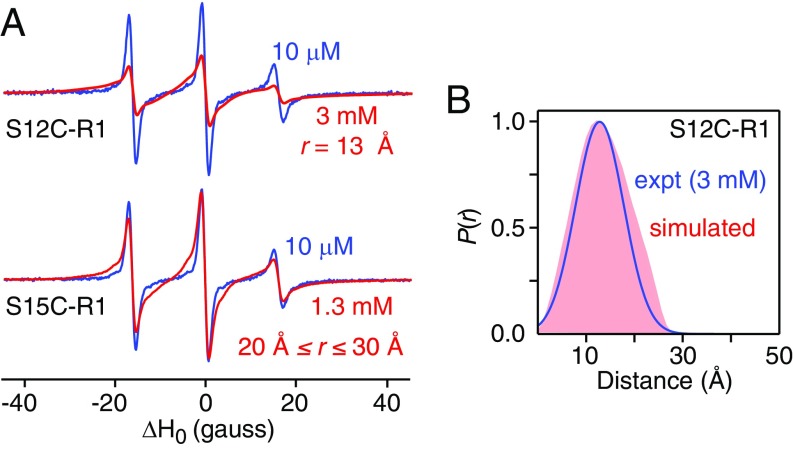Fig. 11.
Validation of the dimeric unit of the PRE-based structures of the httNTQ7 dimer by X-band CW EPR measurements on dimeric GB1-httNTQ7 (S12C-R1) in solution. (A) Comparison of CW X-band EPR spectra of GB1-httNTQ7 (S12C-R1) (Top) and GB1-httNTQ7 (S15C-R1) (Bottom) at low (blue) and high (red) concentrations. The derivative EPR spectra are normalized to the double integral. At 10 μM, both samples are monomeric; at 3 mM, GB1-httNTQ7 (S12C-R1) is largely tetrameric (SI Appendix, Fig. S14); at 1.2 mM, GB1-httNTQ7 (S15C-R1) is largely dimeric (Fig. 9 and SI Appendix, Fig. S15). The broadening observed at the high concentration of GB1-httNTQ7 (S12C-R1) is due to strong dipolar coupling between closely spaced S12C-R1 labels within the dimeric unit of the tetramer and corresponds to a distance of 13 Å. (Note the interdimer distances between S12C-R1 labels in the PRE-based structure of the tetramer are too large to cause any significant line broadening of the CW EPR spectrum.) As a control, the high concentration GB1-httNTQ7 (S15C-R1) sample exhibits only minimal line broadening corresponding to a distance between 20 and 30 Å, fully consistent with the results from DEER EPR (Fig. 10). (B) Comparison of the experimental P(r) distance distribution between S12C-R1 labels (blue) derived from the CW EPR data using the program ShortDistances (27) with the corresponding intradimer average P(r) distribution calculated from the PRE-based structures with dimer-to-tetramer partitioning ranging from 0%:100% to 90%:10% (light red).

